The best Chinese beef stew (柱侯蘿蔔炆牛腩) I have ever tasted was at an old-school coffee shop in Aberdeen, Hong Kong.
They cooked traditionally, nothing fancy, but did it exceptionally well. Serve with a bowl of noodles on the side. The rich flavor is heavenly.
After a few months of not enjoying the beef stew, I am tempted to develop my version of this comfort food since I do not visit Hong Kong often.
I grew up eating Cantonese food and still prefer Cantonese food as my staple over other forms of cooking. Therefore, I am keeping this Chinese beef brisket recipe close to the traditional Cantonese style.
It is a relatively easy Chinese beef brisket recipe. The most critical ‘technique’ is to be patient- let it stew at low heat for over two hours. Other than that, there are a few tricks that I will highlight in the following sections.
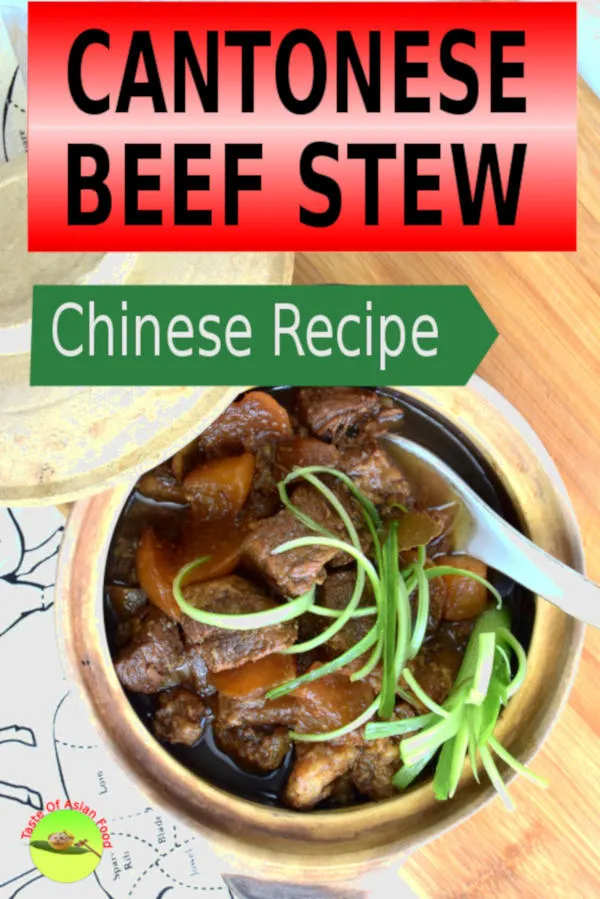
Note: This post may contain affiliate links. Please read my privacy policy for more info. I may receive commissions for purchases made through links in this post. As an Amazon Associate, I earn from qualifying purchases.
How to make Chinese beef stew (Cantonese style)
1. Blanch the beef brisket
The beef tendon and brisket are the most suitable cuts of meat for this Chinese beef stew. Both are tough but very flavorful, which is ideal for stewing. Other cuts of beef like chuck, beef shanks, short ribs, rough flank, and rump can be used, but brisket has layers of fats between the lean meat, which works best for slow cooking.
a. Here are the steps:
- Put the beef in a stock pot.
- Fill up a large pot with cold water to cover the beef. It’s essential to use cold water and uncover as it is more effective to remove larger particles and impurities from the meat.
- Add a few pieces of ginger and half a teaspoon of white peppercorn, which helps to remove the unwanted smell if the meat is not super fresh.
- Bring the water to a boil over medium-high heat, then reduce to low-medium and let it boil for about five minutes.
- Remove the beef chunks once the exterior of the beef has changed color and cooked. It does not matter if the interior is still raw, as we will continue stewing the meat.
- Wash it under running water or with a pot of cold water to remove any blood and impurities.
- Cut the beef brisket into chunks, about 1.5-inch squares.
b. The purpose:
The primary purpose of the pre-treatment before stewing is to remove the unwanted smell from the blood and other impurities of the beef. The ginger and peppercorn also help to get rid of the smell.
Keep the beef fully submerged in cold water and heat it over medium heat. This way is very effective in removing the impurities. You can skip this step if you have a fresh piece of beef or do not mind the raw meat smell.
Throw away the water after blanching the beef. You should use fresh water to stew the beef subsequently.
Suppose you have difficulty cutting the raw beef into chunks. Try one of the following ways:
- Keep the beef in the freezer until it is half-frozen. It is much easier to cut the beef in this state.
- Blanch the whole piece of meat. Cut it only after it cools down. It is easier to cut partially cooked meat than raw meat.
Blanching the whole piece of meat and cutting it later is my preferred method. It will minimize the loss of flavor during the parboiled step.
c. Trick to remove oil
Cut away part of the fat before stewing if the beef brisket is too fatty. For those who do not like too much oil floating on top of the beef stew, you can use the following method to remove it effectively.
- Stew the beef until it is nearly done. Then let it cool completely.
- Remove the beef and the radish using either a thong or pour through a strainer/colander.
- Transfer the stew liquid to the freezer until the oil floating on the surface solidifies to form a solid layer. It may take half an hour, but it depends on the actual amount.
- Remove the solid fat and keep the stewing liquid at the bottom of the container. Transfer the liquid and the beef back into the pan and then stew until the beef is tender.
You do need extra time to carry out this step. The beautiful part of this Cantonese-style beef stew is that it gets tastier after keeping it overnight. This is because the flavor from the stew liquid will penetrate fully into the beef while keeping for a longer time. If you plan your cooking earlier, you can divide your work into two days, which will not take much time from you as it is passive cooking!
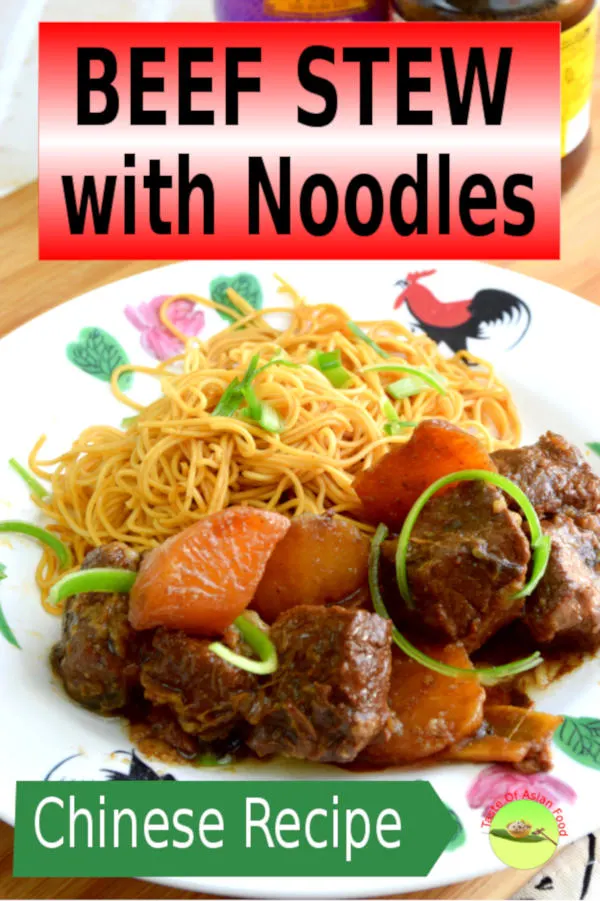
2. The Chu How sauce 柱侯醬
Asian beef stew involves ingredients with different flavors from other cuisines. One of the indispensable ingredients in this Cantonese beef stew recipe is the Chu How sauce (also spelled ad chee hou sauce)
You should be able to get it in most Asian markets. However, if you have difficulty describing it to the shopkeeper, show him the image on this page!
If you cannot get it, use Hoisin sauce plus a few extra garlic cloves as the substitute.
History of Chu How sauce (Chu Hou paste)
Legend has it that the Chu How sauce was invented over two hundred years ago at a restaurant next to the Zumiao Temple in Foshan, Guangdong. The owner, Mr. Leong, was a creative chef passionate about his work. He liked to experiment with different concoctions of sauces.
Besides operating the restaurant, Leong also manufactured a range of sauces for the local community. One of the sauces has been sold to Hong Kong and Macau. His sauces were made mainly from soybean and flour, then fermented, dried, and cooked to a paste with oil, sugar, and sesame. The sauce was so famous that it was named after his first name, Chu How.
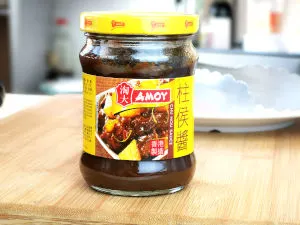
3. Rock sugar
There is a belief that stewing with rock sugar can tenderize the beef. I have not been able to verify this belief. According to a study entitled “Studies on Chinese rock sugar: Analysis and taste,” there is very little difference between the proximate composition of rock and refined sugar. Taste panel tests also showed no significant difference in the sweetness and taste quality from refined sugar.
The taste of rock sugar does have some differences from certain types of sugar. Rock sugar has a clean taste with no caramel tones, so the Chinese prefer it over brown sugar for their cuisines.
4. Radish
Radish compliments the flavor of beef very well. In addition, the radish absorbs the flavor of stew liquid, which has loads of beef flavor. It tastes even better the next day!
Cut the radish into wedges about the size of the beef. Add the radish to the stew in the last forty-five minutes of cooking since it takes less time to turn soft than beef.
You can omit the radish or reduce the quantity as the recipe states. However, it has a slightly bitter taste and may not be the favorite for everyone. Another alternative is adding some carrot or other root vegetables, but the traditional way only uses radish.
5. Other ingredients in the Chinese beef stew recipe
Besides the main ingredients, other common seasoning ingredients are Hoisin sauce, Chinese light soy sauce, oyster sauce, and dark soy sauce. You may also add some rice wine or Shaoxing wine at the end of cooking.
As for the aromatics, ginger, garlic, and some scallions (green onion) are sautéed in the wok before adding the partially cooked beef.
Three dry herbs are used in the Chinese beef brisket recipe- star anise, bay leaves, and sun-dried tangerine peel (Chenpi/陈皮)
While the first two are universal to other cuisines, the sun-dried tangerine peel (also called Mandarin orange peel) is very specific to Chinese food. As a result, it can be challenging to get outside of Asia. Fortunately, it will not make a huge difference if you omit this item.
This Cantonese beef stew is best served with rice or noodles. It can be kept for up to two weeks in the frozen state without losing noticeable flavor. I suggest you make a large batch and portion it for your convenience.
I use a pot for cooking the stew on the stove. You can use a Dutch oven, slow cooker, or an instant pot pressure cooker (or other brands of multi-cooker) to stew the beef. To use the multicooker for making beef stew, select the saute mode and saute the ginger, garlic, and spring onions (spring onions) until they become aromatic. Then, add the blanched beef and all the other ingredients mentioned in the recipe. Finally, choose the pressure cook mode of your multicooker to cook the beef.
Related recipe to this Asian beef stew recipe
If you like this Chinese cuisine, you will also be interested in checking out the following recipes:
Taiwanese Beef Noodle Soup. This noodle soup is prepared using another recipe for beef stew. It is hard to resist when the remarkable aroma and steam from the bowl waft up.
Beef stir-fry with ginger and scallion. If you like beef, check out this straightforward recipe for beef stir-fry. Right onto your dining table from the kitchen within half an hour is simple and easy.
Soy Sauce Chicken. This is a famous Cantonese cuisine that is easy to prepare. The flavor is exceptional, achieved using the top-quality premium soy sauce and poaching at a sub-boiling temperature.
The Chinese beef stew recipe
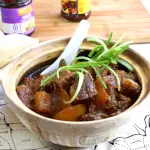
Chinese beef stew recipe
The best Cantonese style beef stew 柱侯蘿蔔炆牛腩 I have ever tasted was at an old school coffee shop in Aberdeen, Hong Kong. The Cantonese beef stew is best to serve with steamed rice and noodles.
Ingredients
Blanch the beef:
- 1kg beef brisket, cut into 1”x2” pieces
- 3 slices ginger
- 1/4 tsp white peppercorns
For sauteing:
- 1 tbsp vegetable oil
- 1 tsp minced garlic
- 3 slices ginger
- 1 stalk of scallion, cut into short pieces
Seasoning:
- 2 tbsp chu hou sauce
- 1tbsp oyster sauce
- 1tbsp hoisin sauce
- 20g rock sugar
- 2 tbsp Shaoxing wine
- 1 tbsp light soy sauce
- 1 tsp dark soy sauce
- 1.5 tsp salt
- Water enough to cover the beef
Others:
- 250g daikon radish
- Scallion for garnish
- 2 star anise
- 1 piece dried tangerine peel 陳皮
- 2 bay leaves
Instructions
- Place the beef, ginger, and peppercorn in cold water, enough to cover the beef. Bring the water to a boil. Let it boil for about five minutes. Remove the beef, wash, and cut it into chunks.
- Heat some vegetable oil. Saute the ginger, garlic, and scallion until aromatic. Add the blanched beef. Stir-fry for five minutes or until the beef turn slightly brown.
- Add the ingredients to the seasoning section.
- Add the dried orange peel, bay leaves, and star anise.
- Add sufficient water, just enough to cover the beef.
- Stew over low heat for two hours. Turn the beef occasionally to avoid sticking to the bottom of the pan.
- Add the cut radish. Continue cooking for 30-45 minutes or until the radish becomes soft.
- Dish out and garnish with chopped scallion.
Notes
If you encounter any audio / visual problems with viewing this video, you can view it from YouTube by clicking this link, which will open in a new tab.
You can use slow cooker instead of stewing on the gas stove,
Recommended Products
As an Amazon Associate and member of other affiliate programs, I earn from qualifying purchases.
-
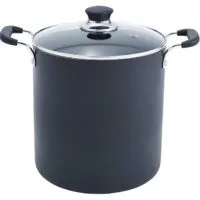 T-fal B36262 Specialty Total Nonstick Dishwasher Safe Oven Safe Stockpot Cookware, 12-Quart, Black
T-fal B36262 Specialty Total Nonstick Dishwasher Safe Oven Safe Stockpot Cookware, 12-Quart, Black -
 Cuisinart CTG-00-3MS Set of 3 Fine Mesh Stainless Steel Strainers
Cuisinart CTG-00-3MS Set of 3 Fine Mesh Stainless Steel Strainers -
 ExcelSteel 242 5-Quart Stainless Steel Colander
ExcelSteel 242 5-Quart Stainless Steel Colander -
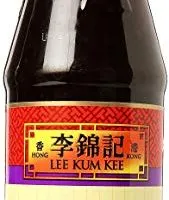 Lee Kum Kee Hoisin Sauce, 20 oz
Lee Kum Kee Hoisin Sauce, 20 oz -
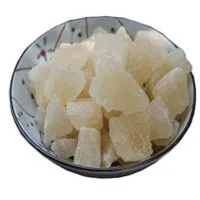 Helen Ou @ Guangxi Specialty: Traditional Pure Brown Rock Sugar 17.6oz
Helen Ou @ Guangxi Specialty: Traditional Pure Brown Rock Sugar 17.6oz
Nutrition Information:
Yield: 2 Serving Size: 2 portionsAmount Per Serving: Calories: 1887Total Fat: 110gSaturated Fat: 41gTrans Fat: 0gUnsaturated Fat: 54gCholesterol: 568mgSodium: 3087mgCarbohydrates: 55gFiber: 7gSugar: 23gProtein: 161g
This data was provided and calculated by Nutritionix on 4/3/2019

Emily
Monday 18th of September 2023
Thank you for this recipe and your descriptive explanations. You are wonderful! :o)
Alee
Thursday 15th of September 2022
Hello Mr. Kwan,
I was wondering how much water to put after last ingredients were incorporated. It was not noted on your recipe. Thank you!
KP Kwan
Saturday 17th of September 2022
I added just enough water to cover the beef after incorporating all the ingredients.
DIYCookingLearner
Thursday 13th of January 2022
Hello Mr Kwan:
Thank you for your recipes. I bought some Chinese beef brisket and want to make this dish. Another video maker suggested using spices such as fennel and cinnamon. What do you think? Thanks.
KP Kwan
Saturday 15th of January 2022
It is nice to use fennel and cinnamon, making it taste different but still tasty.
Ho
Tuesday 20th of April 2021
Another recipe suggested to stew the beef and radish at the same time so that both ingredients will be more flavourful and soft/tender. What are your thoughts on it?
KP Kwan
Wednesday 21st of April 2021
It all depends on the softness of the radish and again depends on the thickness you cut them. Sometimes I did that too. If you keep it overnight, the radish will be even more flavorful :)
CynT
Thursday 11th of March 2021
Hi, I saw your recipe and looks yummy. However, I have no access to zhu how sauce. Is there a substitute for that? Thanks in advance.
KP Kwan
Friday 12th of March 2021
The closest is the same amount of hoisin sauce as the substitute of zhu hou sauce.